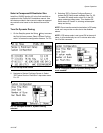
System Operation
54 312776F
6. Adjust component A and B fluid supplies
as needed for your application. Use low-
est pressure possible.
7. Do not exceed the maximum rated work-
ing pressure shown on the system identification
label or the lowest rated component in the system.
8. Open the fluid supply valves to the
system.
9. Adjust the air pressure. Most appli-
cations require about 80 psi (552
kPa, 5.5 bar) air pressure to operate properly. Do
not use less than 75 psi (517 kPa, 5.2 bar).
10. If using a gun flush box, place the gun into the box
and close the lid. Press the Purge key on the
Booth Control. The purge sequence automatically
starts.
If the gun flush box is not used, trig-
ger the gun into a grounded metal
pail until the purge sequence is com-
plete.
When done purging, the Booth Control automati-
cally switches to Standby mode.
11. Adjust the flow rate.
The fluid flow rate shown on the EasyKey Status
screen is for either component A or B, depending on
which dose valve is open. The fluid supply lines on
the screen highlight to show which dose valve is
open.
Watch the fluid flow rate displayed on the Status
screen while the gun is fully open. Verify that the
flow rate of components A and B are within 10% of
each other.
If the fluid flow rate is too low: increase air pres-
sure to component A and B fluid supplies or
increase the regulated fluid pressure.
If the fluid flow rate is too high: reduce the air
pressure, close the fluid manifold dose valves fur-
ther, or adjust the fluid pressure regulator.
NOTE: Pressure adjustments of each component will
vary with fluid viscosity. Start with the same fluid pres-
sure for component A and B, then adjust as needed.
NOTE: Do not use the first 4-5 oz. (120-150 cc) of mate-
rial as it may not be thoroughly mixed due to alarms
while priming the system.
12. Turn on atomizing air to the gun. Check the spray
pattern as instructed in your spray gun manual.
NOTE: Do not allow a fluid supply tank to run empty. It
is possible for air flow in the supply line to turn gear
meters in the same manner as fluid. This can lead to the
proportioning of fluid and air that meets the ratio and tol-
erance settings of the equipment. This can further result
in spraying uncatalyzed or poorly catalyzed material.
F
IG. 63. Status Screen Flow Rate Display


















